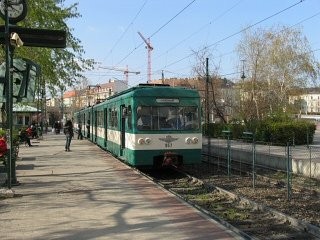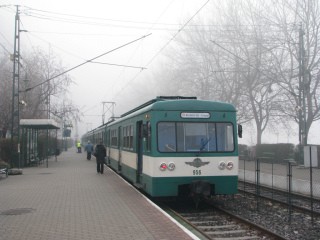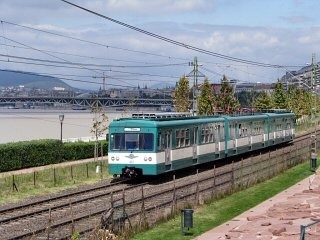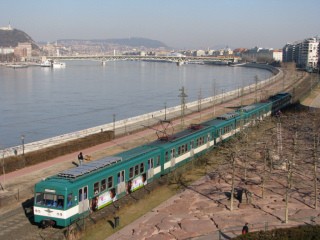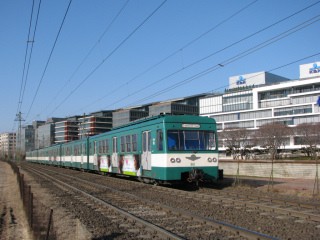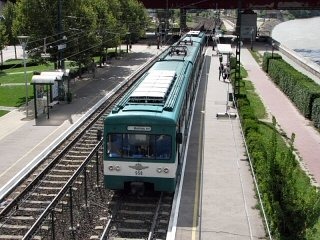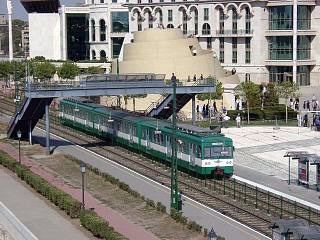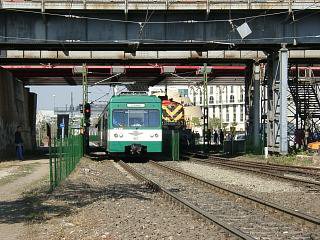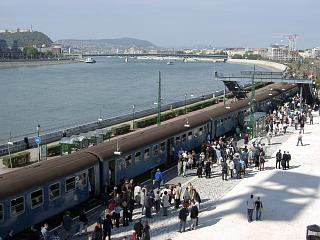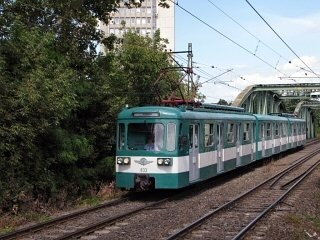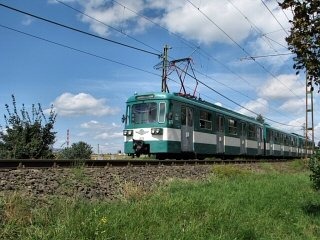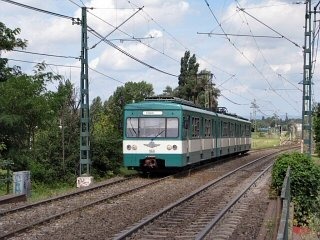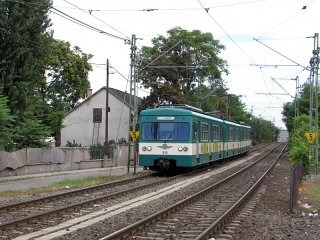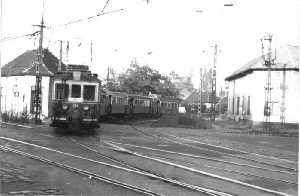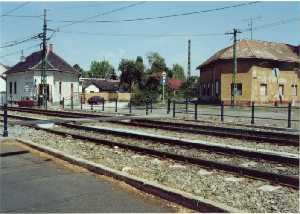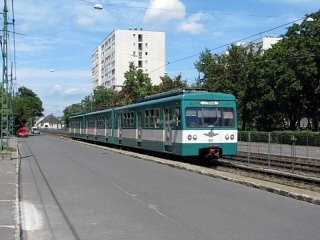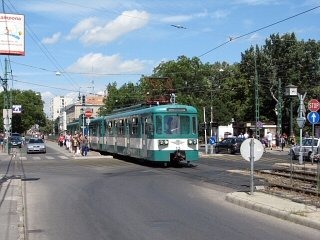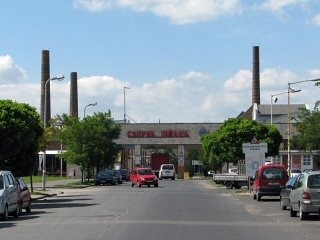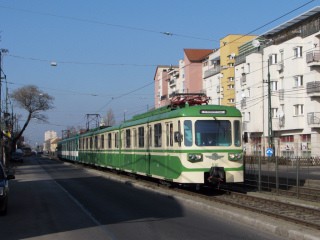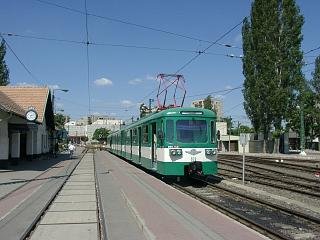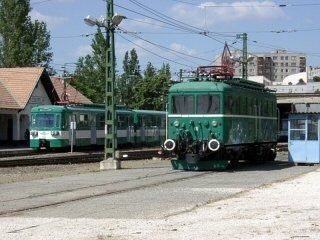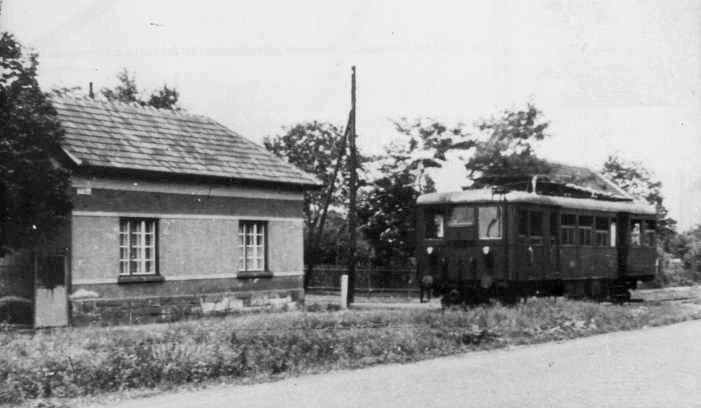Latest update: 26. April, 2012
The Csepel HÉV
The word "HÉV" (pronounced like "hayw") is an abbreviation, it stands for "railway of vicinal interest" (helyiérdekű vasút). In common railway usage these were mostly third-class railway lines built upon lighter specifications to enable feasibility where a "normal" railway line would have been too expensive. In the Budapest way of using this name, a HÉV is usually a commuter railway line (or a branch of lines) reaching out into the suburbs/agglomeration. Historically, there were two kinds of Budapest HÉV lines: railways operating like a real railroad (with steam engines, stations, signalisation and everything), and tram lines that were built as HÉV lines to play around with tax regulations and laws. HÉV lines of the first kind are mostly still there, converted to electric light railways from around 1910. The other sort has either been closed since the 1960s, or they still exist as parts of tram lines (e.g. the outer parts of tram 41, 47, 50).
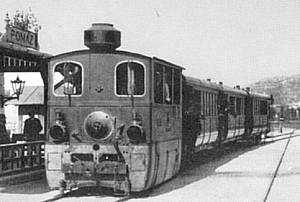
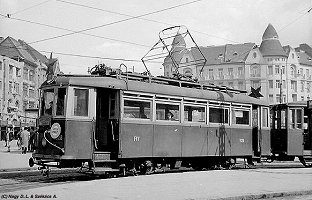
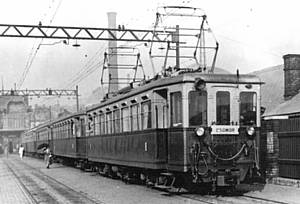
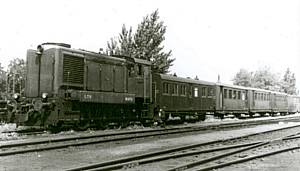
Four different faces of
the Budapest HÉV: steam train to Szentendre at Pomáz in 1888
(upper left), tram-like vehicle at Móricz
Zsigmond körtér in 1957 (upper right), large EMU train to Gödöllő
near Keleti pályaudvar in the 1930s (lower left) and diesel-powered
train at Ráckeve in the late 1950s, early 1960s (lower right). Photos:
villamosok.hu/collection of Zoltán Ádám Németh + András Székács and Dénes
Lajos Nagy
And then there's the HÉV line to Csepel...
The name BHÉV refers to the company building and/or - until 1967 - operating most of the Budapest HÉV lines. The original BHÉV company was a spin-off of the tram company BKVT, founded in 1889. After the joint transportation company BSzKRt was formed, it took over the HÉV lines. After the nationalisation of BSzKRt, the vicinal branch was carved out to the municipal company FHVKV in 1949. One year later the company was renamed to FHÉV. In 1952, the Budapest HÉV lines were grouped into the hungarian state railway company MÁV: from then on they were known as MÁV-BEV: "MÁV Budapest Suburban Railways". Still, some lines - the ones that took usage of tramway tracks - were actually operated by FVV, the capital tramway company. In 1958 the MÁV-BEV lines were branched off to a new BHÉV, returning them to municipal control. In 1967 BHÉV was affiliated into BKV.
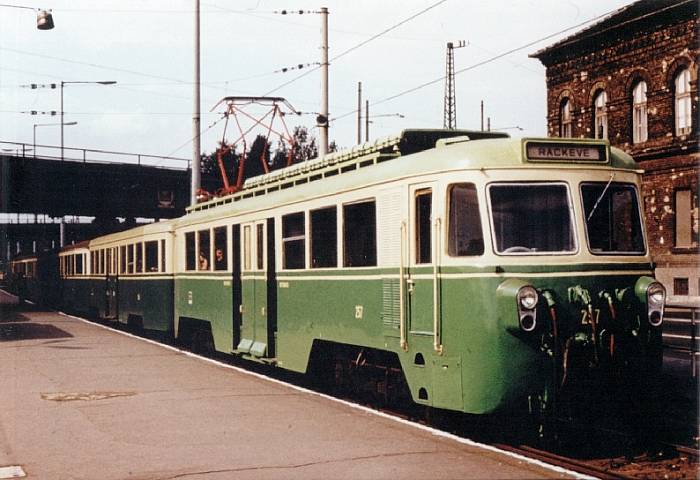
The type MVIII EMUs were
originally destined for the Csepel line, but their production was
delayed, so they were used on the Gödöllő and then the Ráckeve
line. Photo: Rudolf Lakos / villamosok.hu/bhev
Nowadays there are four+one HÉV lines in Budapest:
- Batthyány tér - Békásmegyer - Szentendre (railway line 250), called H5 since May 2011
-
Örs vezér tere - Cinkota - Gödöllő
(railway line 253), called H8 since May 2011
with an additional Cinkota - Csömör branch, called H9 since May 2011 - Közvágóhíd - Dunaharaszti - Ráckeve (railway line 252), called H6 since May 2011
- Boráros tér - Csepel (railway line 251), called H7 since May 2011
These line groups are all electrified with 1000 volts DC and use the same kind of normal-gauge rolling stock. The main HÉV workshop is located at Cinkota, but other lines have certain workshop facilities, too. The lines are not connected directly, transports take place over the state railways.
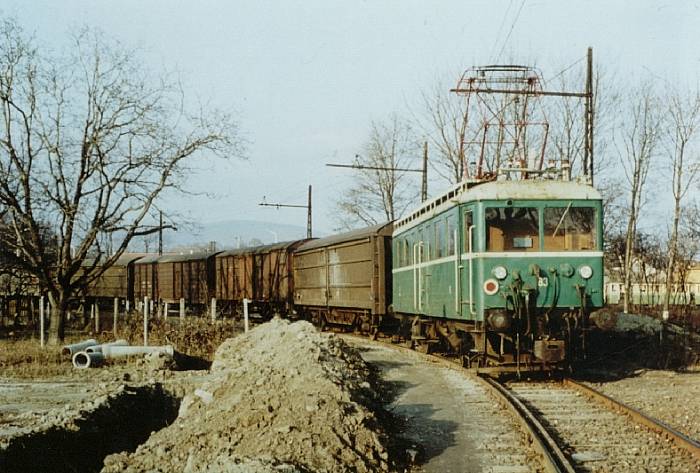
HÉV freight train around
Szentendre
in the late 1970s, photo: Rudolf Lakos villamosok.hu/bhev
Until 1996 the HÉV - with the exception of the Csepel line - sported relatively strong freight traffic to factories along their lines over an extensive network of sidings. For this they had their own engines (electric and diesel) and also quite a few special types of goods wagons. The Budapest HÉV even had its own UIC "railway vehicle owner's code": number 44 (which was later given to Railways of the Bosnia-Hercegovina Serb Republic).
Remark: The terms "HÉV" and "suburban railways of Budapest" are not synonyms - the state railway company MÁV operates its own network, with its own suburban trains, using its own heavy rail rolling stock. That network does not overlap with the HÉV network, nor is there shared usage.
Csepel was once the seat of the chieftain Árpád when hungarian tribes annexed the Carpathian basin around 900AD. Due to the fact that the settlement was located on an island (Csepel-sziget), it remained a separate village until it was incorporated into Budapest in 1950. The settlement had heavy industry since 1892, when the Weiss brothers built an ammunition factory (1892), then and a foundry (1896) and then extended it with a steel-works (1911), which evolved into the huge Weiss Manfréd Works. By the 1940s, the portfolio was reaching from tanks to motor bikes, from machine tools to electrodes. In 1946 the WM Works were nationalised and were renamed to Csepel Művek. Even though most of the factories that formed this industrial conglomerate are dead by now, there's still a bit of life inside the 200-acres battery occupying the island between the HÉV line and the Danube for kilometers and kilometers. It's like a dead town full of disused factory halls, bunkers and miles and miles of tubes and tracks...
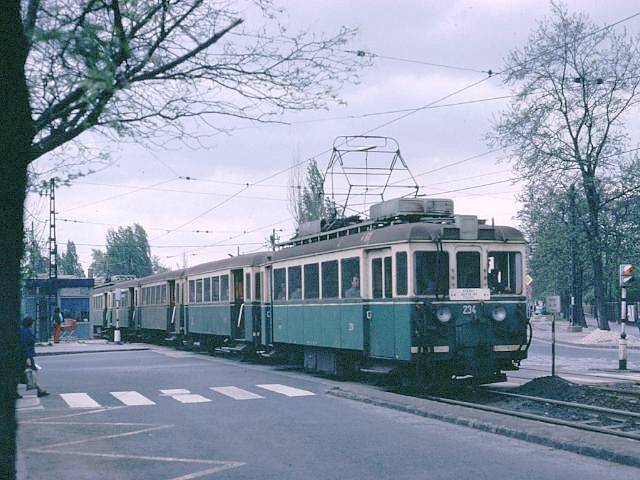
Long train of four-wheelers
on the Csepel - Határ út service in II. Rákóczi Ferenc út
(around 1978). Photo: Heinz Heider
These industrial facilities were the primary reason why the first HÉV line to Csepel was opened in 1912. It was a branch of the Közvágóhíd - Dunaharaszti - Ráckeve HÉV, arriving to the island via the Gubacsi híd after branching off at Pesterzsébet. Its southern terminus was the same as today's, but the line was running perpendicular to the current alignment outside the settlement. In 1938 a direct service was launched to Pesterzsébet - the remains of which are still part of today's tram line 52. The blooming industrial district Csepel of course still lacked a direct rail connection to the inner city, so a new "express" light railway was built and opened in 1951: this is what we now know as the Csepel HÉV.
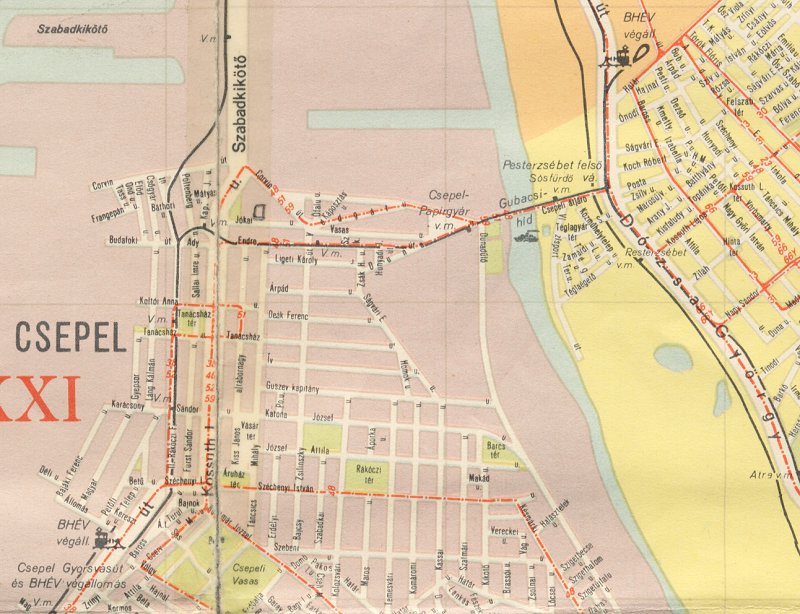
The new, direct line between
Boráros
tér and the old one to Pesterzsébet (Határ út) seen together
on this map from the 1960s. Also seen the single-track diesel service starting
soutwards from the Csepel terminus.
The old line was thought to be redundant then, so the Közvágóhíd - Csepel and Pacsirtatelep - Csepel services were cancelled. This was undone in 1959, when a Csepel - Határ út service was launched. That year another HÉV line was opened, and it was a real strange one: built as an unelectrified single-track line (with a passing loop in the middle) starting at the Csepel terminus, the Csillagtelep/Hárosi iskola service only lasted until 1965. In 1978, the Határ út service was closed again, but this time it was final. What remained is what we can see today...
Route: Boráros tér - quay - Kvassay híd (bridge) - Szabadkikötő út - II. Rákóczi Ferenc út - terminus (6.7 km)
Vehicles: motor+trailer+motor
trains in single or double configuration (3 or 6 cars)
M.IXa
+ P.XXVIIa + M.IXa: built in Hungary between 1963 and 66
M.Xa
+ P.XXVIIIa + M.Xa: built by LEW Hennigsdorf of East Germany, between
1975 and 83
Remark: Because this HÉV line runs entirely within the city boundaries, it can be used with normal BKV passes and tickets - no complementary tickets or passes are needed.
![]()
The HÉV has a simple two-track terminus by the Danube, featuring two crossovers in a row before that platforms.
-> Over
to route 2/2A at Boráros tér
->
Over to route 4/6 at Boráros tér
This is not a tramway line, so the tracks are fenced off.
Despite the fences, one can make relatively nice photos of the trains.
The backdrop consists of freshly-built office and apartment buildings. This area used to be a shunting yard that was started to get built in in 2000 (it's still far from complete).
This is a new stop, opened in 2000, when tram line 1 was extended to Lágymányosi híd (Lágymányos bridge). Although the bridge itself was renamed to Rákóczi híd in 2011, the stop retained its name. From May 2012 it's called Közvágóhíd.
Also quite new is the Palace of Arts (Művészetek Palotája) and the National Theater.
There's a pedestrian flyover bridge at the stop, from which one can take photos of the HÉV trains - or from the southern skyline of the city. There's also a strange, zikkurat-like superstucture next to the tracks. If you climb to the top of it, you'll have a slightly different angle of view at the HÉV and the city.
For a while, the remnants of the shunting yard once occupying this area up to Boráros tér served as a connection to the state railway network, allowing special passenger trains to roll up right in front of the National Theater. This connection was removed a few years ago, so you cannot make photos like the ones above anymore.
->
Over to route 1 at Közvágóhíd
-> Over
to route 2 and 24 at Közvágóhíd
After a bit of winding, the HÉV crosses the Ráckeve Danube-arm (Ráckevei-Duna) separating Csepel from Pest. You can see the Danube lock from the train, but if you want to take a photo of a HÉV on the bridge, you have to either walk quite a bit, or take bus line 179.
The line runs on an embankment along the main road to Csepel, without much stopping. Looking towards west through the windows of the train you'll see sewage works, abandoned storage areas of the Budapest Free Port, and then the Free Port itself.
Before reaching the stop Szabadkikötő, you'll see the new connecting tracks to the state railway network. This is the only rail connection of this HÉV line to anywhere else. Originally the connection was near the Boráros tér terminus, but was then removed to about where now the National Theater is, then a bit more to south, and then to here. Since this HÉV line never offered freight service (the port and the factories had their own sidings leading to the state railways), this connection is only used for internal transports, e.g. units going to the Cinkota HÉV workshop (located along the Gödöllő HÉV line) for repairs, etc.
Suddenly the small village with single-story houses turns into a high-rise housing area. This is how the political regime of the 1950s and 60s imagined a socialist industrial town.
Although the HÉV runs on reservation in the middle strip, due to the level crossings and the fact that the HÉV vehicles don't have magnetic track brakes, their speed is restricted. Szent Imre tér is the centre of Csepel, thus it's a busy stop: civil offices, a bus station, etc.
The slow running continues until the terminus, which is near the water tower in the background.
The terminus is located next to a newer segment of the communist-type housing area. These houses were built during the late 1980s, probably even a bit later. By now the densely populated area has grown over the end of the HÉV line, yet there is no talk about the extension towards south. Maybe when the HÉV will be rebuilt as part of the M5 metro line... probably around 2525.
There is a small car-barn right at the entrance of the terminus, the rest is an open-air storage area. Quite possibly you'll even be able to see the old shunter/snow-plough somewhere there (right).
![]()
Back to the
top
Back
to the opening page
Back
to the clickable map
Disclaimer: The author cannot
be held responsible for mistakes, misinterpretations, inaccuracies, inactualities,
etc. on/of these pages, nor for the content of other pages linked in.
![]()
Send
a mail to the author
The
author's homepage
